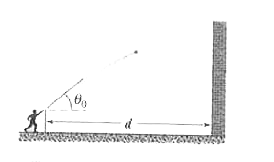A fly ball is hit to the outfield. During its flight (ignore the effects of the air), what happens to its (a) horizontal and (b) vertical components of velocity? What are the (c ) horizontal and (d) vertical components of its acceleration during ascent, during descent, and at the topmost point of its flight?
(a) vx constant, (b) vy initially positive, decreases to zero, and then becomes progressively more negative, ( c) ax=0 throughout, (d) ay=−g throughout
Topper's Solved these Questions
- BOOK - RESNICK AND HALLIDAYCHAPTER - MOTION IN TWO AND THREE DIMENSIONSEXERCISE - PROBLEMS50videos
MOTION IN TWO AND THREE DIMENSIONS
- BOOK - RESNICK AND HALLIDAYCHAPTER - MOTION IN TWO AND THREE DIMENSIONSEXERCISE - PRACTICE QUESTIONS (SINGLE CORRECT CHOICE TYPE)49videos
MOTION IN TWO AND THREE DIMENSIONS
- BOOK - RESNICK AND HALLIDAYCHAPTER - MOTION IN TWO AND THREE DIMENSIONSEXERCISE - PRACTICE QUESTIONS (MATRIX-MATCH)10videos
MOTION IN TWO AND THREE DIMENSIONS
- BOOK - RESNICK AND HALLIDAYCHAPTER - MOTION ALONG A STRAIGHT LINEEXERCISE - PRACTICE QUESTIONS ( Integer Type )3videos
MOTION ALONG A STRAIGHT LINE
- BOOK - RESNICK AND HALLIDAYCHAPTER - OSCILLATIONSEXERCISE - Practice Questions57videos
OSCILLATIONS
Similar Questions
A defense air force plane, diving with constant speed at an angle of 52.0∘ with the vertical, drops a shell at an altitude of 720 m. The shell reaches the ground 6.00 s after its release. (a) What is the speed of the plane? (b) How far does the shell travel horizontally during its flight? What are the ( c) horizontal and (d) vertical components of its velocity just before reaching the ground? Assume an x axis in the direction of the horizontal motion and an upward y axis.
View SolutionThe vertical component of a vector is equal to its horizontal component. What is the angle made by the vector with x-axis ?
View Solution
Knowledge Check
- Question 1 - Select One
An aeroplane takes off at an angle of 60∘ to the horizontal. If the velocity of the plane is 200kmh−1,calculate its horizontal and vertical component of its velocity (in kmh−1) .
Avx=50 , vy=10√3Bvx=50√3 , vy=100√3Cvx=100√3 , vy=100√3Dvx=100 , vy=100√3 - Question 2 - Select One
A ball is thrown horizontally from top of a tower with velocity 30m/s. During its motion, at a particular point horizontal and vertical components of velocity are equal. The time to reach to the instant will be :
A3 secB4 secC5 secD6 sec - Question 3 - Select One
A ball is projected from the top of a tower at an angle 60∘ with the vertical. What happens to the vertical component of its velocity?
AIncreases continuouslyBDecreases continuouslyCRemain unchangedDFrist decreases and then increases
An aeroplane takes off at an angle of 60∘ to the horizontal.If the velocity of the plane is 200kmh−1,calculate its horizontal and vertical component of its velocity.
View SolutionYou throw a ball toward a wall at speed 25.0 m/s and at angle θ0=40.0∘ above the horizontal. The wall is distance d = 22.0 m from the release point of the ball. (a) How far above the release point does the ball hit the wall? What are the (b) horizontal and ( c) vertical components of its velocity as it hits the wall? (d) When it hits, has it passed the highest point on its trajectory?
 View Solution
View SolutionAn aeroplane taked off at an angle of 30∘ to the horizontal. If the component of its velocity along the horizontal is 200kmh−1, what is its actual velocity ? Also find the vertical component of its velocity.
View SolutionA ball is thrown at an angle θ with the horizontal. Its time of flight is 2 s. Its horizontal range is 100 m. What is the horizontal component of velocity of projection ? Take g=10ms−2.
View SolutionAn aeroplane takes off at an angle or 30∘ to the horizontal. If the component of its velocity along the horizontal is 240kmh−1. What is the actual velocity. ? Also find the vertical component of its velocity ?
View Solution

